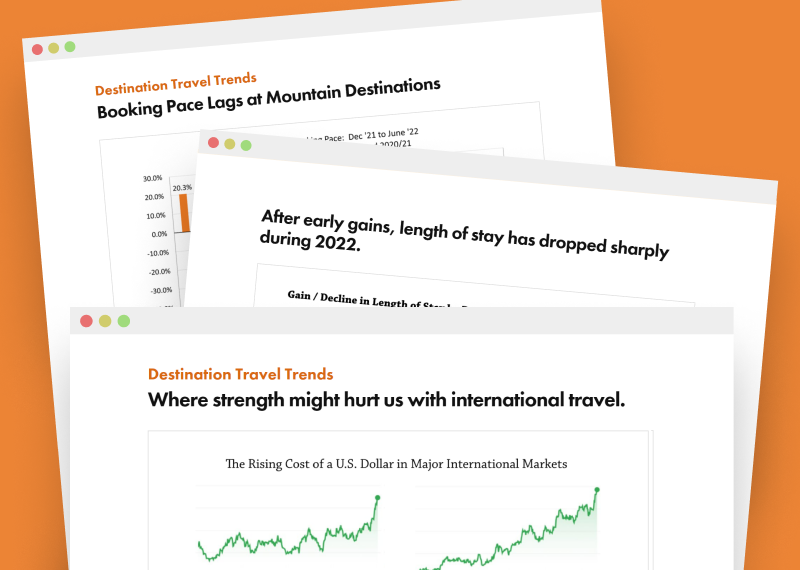

 Tom Foley
Tom Foley
Just as morning follows night, ski resort bookings follow generous snowfall and the month of March was no exception as widespread and sometimes dramatic snowstorms had skiers and riders eagerly booking end-of-season mountain vacations. In the process of a bullish booking month for winter reservations, notable deficits that were on-the-books last fall for the full winter season have now been practically erased. But while lodging properties from 17 mountain communities across seven western states cheer about a winter that will end with strong revenues and reasonable occupancy–with another month still ahead–the summer season is headed in an entirely different direction. Data collected through March 31 by DestiMetrics,* part of the Business Intelligence division of Inntopia, revealed some stark declines in on-the-books lodging for the upcoming summer.
The most recent monthly Market Briefing released last week presents year-over-year comparisons to both last year at this time and four years ago and in March 2019–the last full winter season before pandemic lockdowns shut down travel and skewed comparisons in the subsequent two winters of 2019-20 and 2020-21. This month’s report offers both a single year-over-year comparison alongside a comparison to four years ago during the last full pre-pandemic season. The Briefing also includes some sharp warnings about how the economy is finally starting to rattle the confidence and vacation planning of summer mountain travelers.
Lodging performance in March
Compared to last year at this time, occupancy for the month of March was down 3.3 percent while the Average Daily Rate (ADR) was up a modest 2.7 percent. That minor shift in both variables led aggregated revenues that were down a scant 0.6 percent compared to March 2022. Skipping comparisons to the previous two seasons, a look back at March results in 2019 and the last full pre-pandemic season of 2018-19, occupancy was down 2.8 percent compared to that March while ADR was up a stunning 44.8 percent—much higher than the rate of inflation on many, if not most, other purchases. That huge gain in rates, despite the dip in occupancy, delivered an impressive 41 percent increase in March revenues compared to March 2019.
Excellent winter gets better with March snowfall and overnight visitors
The full winter season from November through April got even stronger with the surge in short-lead bookings as snow-chasers booked late season ski trips. As of March 31, actual and on-the-books occupancy for November through April remains down a slight 0.3 percent although January is still the only month in the 2022-23 season with increased occupancy. In contrast to the slower occupancy, ADR is 6.2 percent from last winter with increases in every month except November. The higher rates are easily offsetting the slight dip in occupancy to provide a 5.9 percent increase in revenues over last year. Drawing comparisons to 2018-19 for the last full winter before the pandemic and a more apples-to-apples comparison, occupancy is up a scant 0.3 percent but ADR is up a whopping 43.3 percent to provide a 43.8 percent gain in seasonal revenues.
“Great snow has offset and even hidden some strong economic headwinds but as that extra lure melts away with the season—even though it will be extended in some destinations—those headwinds are becoming more apparent, even dire in some situations,” cautioned Tom Foley, senior vice president of Business Intelligence for Inntopia. “Beginning in May, occupancy is down sharply and those declines are extending through September at this point,” he continued. “So, although pent-up demand and abundant snow has been protecting the industry from those economic pressures, those factors are no longer a consideration. Some significant consequences are showing up in the data and we’re seeing the deepest declines since early 2020.”
March booking pace was good for short-lead arrivals, but not for summer
Bookings made during March for arrivals in March through August delivered a 5.5 percent gain in actual occupancy for those six months compared to this same time last year with gains being posted for March, April, and August. However, bookings for the early summer compared to those made last March for arrival in the same months were dismal with May down 7.4 percent, June down 11.4 percent, and July down 17.2 percent compared to last year at this time.
As of March 31, on-the-books occupancy for the upcoming summer from May through October is down 13.5 percent compared to last year at this time, ADR is up 6.8 percent and revenues, for the first time in many months is down substantially—7.8 percent. Compared to four years ago at this time and looking back at the summer of 2018, on-the-books occupancy is down 9.9 percent with double-digit declines in the four months from May through August. Despite the decline in occupancy, ADR is up a dramatic 45.3 percent compared to that summer and is delivering very robust aggregated revenues of 30.7 percent.
Econometrics
The Dow Jones Industrial Average (DJIA) clawed back some territory from February’s sharp drop by rising a modest 1.9 percent—617.45 points to close at 33,274.15 points for the sixth month-over-month increase in the past 12 months. “Markets had a mostly positive reaction to a smaller increase in interest rates during the month and appeared to be only slightly concerned with volatility in the banking sector. But most economic forecasts remain somewhat negative with the likelihood of an economic downturn or recession in the next 12 months to be around 65 percent—up from 60 percent in February according to Bloomberg Economics,” explained Foley.
The Consumer Confidence Index (CCI) and the Consumer Sentiment Index (CSI) once again moved in opposite directions during March from the previous month as the CCI edged up a tentative 0.8 percent from 103.4 to 104.2 points while the CSI tabulated by the University of Michigan reversed course from February to drop from 67 to 62 points during March and marking the first decline in the CSI since November.
“Consumers were feeling less optimistic about short-term business conditions, jobs and earning in March but were feeling somewhat more optimistic about longer-term expectations for the economy,” reported Foley.
The national Unemployment Rate dipped from 3.6 to 3.5 percent in March aided by employers putting 236,000 new jobs onto payrolls. This cooler job creation from the past few months indicates that the rising interest rates are having the desired effect of the Federal Reserve Bank to slow the economy without hurting workers while attempting to tame inflation. The Leisure and Hospitality sector had the strongest new job creation during March as 72,000 new jobs were added although mostly in the food and beverage sub-category. Overall positions in the sector are still down approximately 368,000 positions since February 2020.
And lastly but crucially, the national Inflation Rate—the difference in the price of goods this year versus last year—declined from six percent in February to five percent in March—the lowest level since May 2021. The decline was credited primarily to falling gasoline prices but when food and fuel costs are taken out of the equation, core inflation actually rose from 5.5 to 5.6 percent during March and marking the first time it has surpassed overall inflation since early 2021.
“This cool down in inflation could force the hand of destination travel suppliers such as lodging properties and other attractions who have been raising and maintaining historically high rates for a number of nearly two years even though the data has clearly been pointing to some significant consequences in bookings and occupancy for the past 14 months—mainly showing up as shorter stays and fewer bookings,” Foley noted.
Keeping an eye on
*Summer is struggling as a clear and profound downward shift in performance has appeared in most western mountain destinations. Five of the six months that summer data is available are showing declines in occupancy–starting with a ten percent drop for May but as much as 15.5 percent for on-the books arrivals in August compared to last year at this time. Only two of the 17 participating regions are showing positive summer occupancy as of March 31. ADR currently remains up but the sharp declines in occupancy are currently showing a 7.8 percent decline in summer revenues.
*Room Nights Booked (RNB) and Room Nights Available (RNA) tell an even different story about winter occupancy. Absolute RNB is down 3.1 percent—significantly higher than the 0.3 percent decline in winter occupancy and marks another drop down from one month ago. Inflation and rising interest rates have combined to reduce both the number of bookings overall and the length-of stay. RNA (rooms and units in the available rental pool) have also declined and are down 2.8 percent from one year ago as homeowner use of their properties continues to fluctuate.
*Length-of-Stay continues to shrink compared to the significantly longer stays booked in 2021 and 2022 and is down 0.13 percent from a year ago and 0.15 nights from February 2020 just before the pandemic was declared. The drop has been attributed to slackening in pent-up demand, employees returning to their workplaces, and rates remaining historically high. The three elements have combined to shorten the longer stays that surged in the midst of the pandemic.
“A winter season that started with some uncertainty and tepid bookings is wrapping up as one of the best in many years courtesy of the deep and widespread snow that assures mountain lodging will achieve its second-best revenue season ever and come close to last year’s record,” confirmed Foley. “But the celebration is going to be pretty short-lived as persistent inflation and rising interest rates are keeping the economy fluctuating and consumers edgy about destination mountain travel this summer. Bookings for summer arrivals are well below last year at this time and in in order to attract visitors this summer, the lodging community will need to get creative pretty soon with add-on value or enticing rates to overcome consumer caution—which appears to have finally arrived in mountain travel,” he concluded.
Have a question? Just ask.

Tyler Maynard
SVP of Business Development
Ski / Golf / Destination Research
Schedule a Call with Tyler→

Doug Kellogg
Director of Business Development
Hospitality / Attractions
Schedule a Call with Doug→
If you're a current Inntopia customer, contact support directly for the quickest response →
Request Demo
A member of our team will get back to you ASAP to schedule a convenient time.



